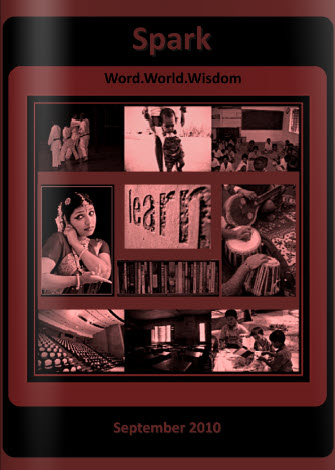by Priya Gopal
[box] Do you think teachers are always the ones who impart knowledge? If you do, think again. Priya Gopal feels that there’s a lot to learn from children too and these are lessons for life. In a tribute to the September 2010 issue themed ‘Learning and Life’s Lessons’, Priya lists 10 important lessons she has learnt from children including her own students.[/box] [box type=”info”] MONTH: September 2010
MONTH: September 2010
THEME: LEARNING AND LIFE’S LESSONS
CONCEPT: September is a month when we honour teachers. The issue was in a way a tribute to what they impart—learning and lessons.
FEATURED PERSONALITIES OF SEP 2010: Anita Ratnam, Actor and Choreographer
Geeta Ramanujam, Director, Kathalaya
Meera Sivakumar, Teach for India Fellow
S.Sowmya, Carnatic Vocalist
Sathya Saran, Fashion Journalist and Author.
This turned out to be one of those serious and thought-provoking issues – why not when it sought to examine education and learning from as many aspects as possible! From arts to life’s lessons to special education, we had it all in this issue. We will remember this issue for the sheer variety in thought and discussion it boasted of. A must read for those who follow and appreciate the various aspects of education. [/box]
Long after the tenets of the English grammar are forgotten, long after Shakespeare has been analysed and the précis been written and the dust has settled on the report cards, when the phone rings and a voice shrieks over, “Ma’am, I am in Mumbai, can I meet you? Do you remember me…?” and an animated voice continues without waiting for a reply, you know here is a student whose life you have touched. And yes, here is a student who has touched your life.
Having been an educator for over 16 years, I have time and again realised that the student-teacher relationship is a rather interesting one. While the most obvious reality is that the teacher is the one who imparts knowledge to the students, how often have teachers themselves looked carefully at some of the little but life’s crucial lessons that a student teaches the world?
If I taught them to listen, speak, read and write, they taught me to perceive, communicate, interpret and inscribe. If I taught them skills to value life, they taught me the values to manoeuvre life. If I taught them the ABC of the English language, they taught me the ABC of the language of life. Here are the 10 most important lessons that I have learnt from observing children, including my students over the years.
- Allow the voice of your heart into your mind: 17-year-old Ronald was a talented dancer. He wanted to be a professional dancer and choreographer. Earlier, Ronald had very fervently shared his dreams with his teachers and lamented his inability to convince his mother. His mother wanted him to become a banker. Lending voice to his dreams, his teachers helped him convince his mother to follow his dreams. Today he travels the world and is an established choreographer only because the voice of his heart led his mind. Learn to listen not just to the voice of your mind but also the voice of your heart.
- Agree to disagree: Peer groups in class present multiple solutions to a situation only because they agree to disagree. Teenagers Rohan and Nishi have diametrically opposite views on almost everything. But since they usually agree to disagree, they create superior work. They know that once they do not step on each other’s toes, they are able to think and perform better. Ego finds room in many an adult heart and makes it difficult for an adult mind to disagree without rancour.
- Be passionate and recognise others’ passions: 12-year-old Krishna was never a go-getter in the classroom but every team wanted him in theirs. They knew he was the best footballer the school could have. He was passionate about football and his classmates cheered him for that. Kids are instinctively passionate. They know what drives them to aim for excellence. An adult in his quest for his own passion may many a time find it, but misses on seeing what accelerates others in life.
- Chase to the finish: Teachers usually wait outside a classroom, for the previous class to be completed. Entry into a classroom doesn’t mean the beginning of the class. More often than not, this is because students are engrossed in completing a painting or cracking a tough math problem or just winding up a diagram from the previous class. Kids chase to finish. They do not like to leave things half done. As adults we often move on to the next task in our task list even when we have not completed one because we are so time-bound.
- Disorder is not always discordant: Adults like to be neat, organised and in charge of everything. Kids can be unruly, disorganised and chaotic. But look hard and you will find a method in the madness, calm in the chaos, a creation in the confusion. An untidy classroom becomes an obstacle course, a torn notebook becomes material for craft and the crowds in a compartment begin to look like atoms in a solid. Disorder is not always discordant. It lies within us to create a new order.
- Let your imagination run riot : Imagination sparks creativity, but as we grow older, we somehow tend to stop using our imagination for the fear of being ridiculed. Kids do not crave to fit into moulds or please anyone with their ideas. They are true to their heart and their imagination always finds a freeway. They can be in space one moment or in the centre of the earth the next. That is only because they let their imagination run riot.
- Live the moment: A student who focuses on the moment is more the rule than an exception in a pre-primary or primary classroom. Undivided attention to the task at hand and the sheer joy of working on a project is visible in the tired smile of a student who makes his submissions. Kids never worry about what’s going to happen tomorrow. That’s why an undone assignment or homework doesn’t bother them much. The focus on one task hardly leaves them with time to even think about the other. But the satisfaction of completing the one at hand is more important than worrying about the undone ones. ‘Next is what’, seems to be the motto of most grownups. ‘Now is life’ is what life seems to be telling us through these kids.
- Recognise the good in others: Kids don’t look at others in his/her group thinking, ‘Is he going to cheat me? Will he take me for a ride?’ They just believe that everyone is intrinsically good. An adult, on the other hand, begins with distrust. They believe the world is out to cheat them. Why do we need the fine print in almost every transaction? This is because we work on the premise that each one of us is out to cheat the other.
- Dream big: Almost every three-year-old wants to grow up into an engine driver. What image could be more powerful than wanting to control an engine that runs an entire train? But as we grow, we let go of our dreams. Our dreams become smaller and smaller in the daily grind of things and one day we stand back and question ourselves: Where did I begin from and where have I ended? Hold on to your dreams, fasten them tightly to your heart and one day they will be so big that you cannot ignore them.
- What is inside matters more: Give any curious child (little or otherwise) a toy car and the possibility that he wants to know what’s inside is more than actually wanting to play with it, reminds you that what is inside matters more than what is on the outside. And that’s perhaps such a valuable lesson – do not get carried away by outward appearances. Remember to look within.
Priya Gopal is the Section Head (CBSE) at the Curriculum Department of Kangaroo Kids Education Ltd., Mumbai. An educator by choice, teaching and interacting with kids is something that has enthused her over the last 16 years. Priya lives in Mumbai with her husband and two children. She blogs at http://keepsmilinginlife.blogspot.com
[box type=”download”] If you have trouble opening the PDF, please right click on the button and select ‘Save Link As/Save Target As’. This will help save the PDF to your computer. If you still have trouble, drop us a mail at editors@sparkthemagazine.com and we will mail you the PDF straight to your inbox! DON’T MISS THE PDF EXPERIENCE![/box] [button link=”https://sparkthemagazine.com/wp-content/uploads/2012/01/spark-january-2012.pdf” color=”red” newwindow=”yes”] Read it all at one go! Download the PDF here![/button] [button link=”http://issuu.com/sparkeditor/docs/spark-january-2012?mode=embed&layout=http%3A%2F%2Fskin.issuu.com%2Fv%2Fcolor%2Flayout.xml&backgroundColor=000000&showFlipBtn=true” color=”green” newwindow=”yes”] Flip and read like a mag on the e-reader! Click here![/button]
[facebook]Share[/facebook] [retweet]Tweet[/retweet]









Wow…bang on target Priya…the start was fantastic so as the follow up lines and the 10 headings t are self explanatory…cool stuff….i will also like to share few other things that we can learn from them…..is their ability to forgive and forget….their enthusiasm for the new things..their courage to ask questions without perceptions and prejudice…their faith in their relations ,isn’t it? Was really a nice one..keep writing and keep sharing…..
Superb chase to the finish. Thank YOU for reminding the commandments of the world of the CHILD. Great observation Priya! Well done.
Beautifully compiled! Every point is a gem. I’ll treasure this.
Thank you . My honour